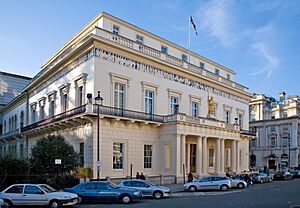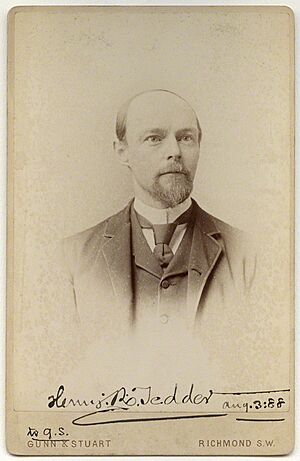Athenaeum Club, London facts for kids
The Athenaeum is a special private club in London, England. It was started in 1824. This club is mainly for people who love learning and have achieved great things. Members often come from fields like science, engineering, writing, or the arts. Famous scientists like Humphry Davy and Michael Faraday were among its first leaders. Over 50 Nobel Prize winners have been members of this club.
The club's building is located at 107 Pall Mall. It stands on the corner of Waterloo Place. The famous architect Decimus Burton designed the building. He used a style called Neoclassical, which looks like ancient Greek and Roman buildings. Decimus's father, James Burton, whose company built the club, was a well-known property developer in London.
The clubhouse has a grand entrance with columns, called a Doric portico. Above the entrance, there is a statue of Athena. She is the classical goddess of wisdom, and the club is named after her. The detailed carving above the columns, called a frieze, is a copy of the famous Parthenon temple in Athens. Inside, the club has a huge library and a dining room. It also has a Morning Room, a drawing room, and bedrooms for members.
Contents
How the Club Started
The Athenaeum Club began in 1824. John Wilson Croker, who worked for the Admiralty, had the main idea. He was very important in setting up the club. In 1823, Croker suggested to Sir Humphry Davy that they create a club. He wanted a place for people interested in literature, science, and art. Croker felt that other clubs were mostly for military or fashionable people. Artists and writers needed their own space.
Croker suggested 30 important names for the club's first committee. Almost everyone he asked agreed to join. The first meeting of the Athenaeum happened on February 16, 1824. It took place at the Royal Society's rooms. A committee was formed to get the club started. Sir Humphry Davy became the first chairman. Michael Faraday was the first secretary. Faraday soon became too busy and had to resign, but he stayed a member. By December 1824, the club had grown to 1,000 members.
By May 1824, the club rented temporary rooms at 12 Waterloo Place. This building was also built by James Burton's company. His son, Decimus Burton, who was only 24, was asked to design a permanent clubhouse. They first picked a site on Pall Mall East, but it was too small. Then, the government offered them a part of the land where Carlton House used to be. The club accepted this offer.
The Clubhouse Building
Decimus Burton was chosen to design the clubhouse at 107 Pall Mall. It is on the corner of Waterloo Place. Even though he was young, Decimus Burton had already designed many important buildings in London. His clubhouse is in the Neoclassical style. It has a grand entrance with columns. One expert called it "a building of remarkable grace." The central staircase inside is also very unique.
Burton designed many of the club's decorations himself. This included the clock cases and light fixtures. When the clubhouse was finished in April 1830, the club committee was very happy. They praised Burton's skill and the beauty of his designs.
The original building had two main floors. A third and fourth floor were added later in the 1800s. There is a continuous railing on the first floor. It has a beautiful and expensive frieze. This frieze was designed by Decimus Burton. It was made by John Henning, a leading sculptor. The frieze is a copy of the famous Parthenon marbles from Athens. These marbles show the Panathenaic procession. John Wilson Croker really wanted this frieze, even though it cost a lot.
Building work started in 1827 and finished in 1830. The statue of Pallas Athene above the porch was put up in the same year. The total cost was about £43,100. This was a bit more than planned, due to gas fittings and furniture.
A copy of the famous Apollo Belvedere statue was given to the club by Decimus Burton. It is at the top of the main staircase. Statues of Venus and Diana, which are copies of ancient statues in the Louvre museum in Paris, are on either side of the hall.
Club Membership Rules
The new building was ready by early 1830. The first big meeting was held there on May 30, 1830. In the same year, a new rule was added. It allowed the committee to choose up to nine people each year. These people had to be very famous in science, literature, or the arts. This special rule is still a key part of the club today. It now also includes people known for "public service." Regular members used to be chosen by a vote.
The Duke of Wellington was one of the club's first members. There is a stone outside the front porch that he requested. It helped him get on his horse. You can still see it today.
After the building was finished, the club needed more money. So, in 1832, they decided to add 200 more members. This helped their finances. But soon, more money was needed to improve the building's air flow and gas lighting. The club was one of the first buildings to use gas lights. In 1838, the number of members was increased to 1,200. This meant 40 more members were added. These new members were called the "Forty Thieves." They included very famous people like Charles Dickens and Charles Darwin.
The number of members stayed at 1,200 for a long time. Today, it has increased to 2,000. In the past, there was always a very long waiting list to join the club.
Club Librarians
The first librarian of the Athenaeum was Spencer Hall. He was appointed in 1833. He was recommended by Edward Magrath, who took over from Michael Faraday as the club's first secretary.
In 1874, Henry Richard Tedder became Spencer Hall's assistant. Before that, he was the librarian for John Dalberg-Acton, 1st Baron Acton, who was an active member of the club. Hall passed away in 1875, and Tedder became the librarian. He also became the secretary in 1888. He worked there until he retired in 1914.
Later Club History (to 1914)
At first, the club got its water from a well and other sources. A proper public water supply was connected in 1853. A basic drainage system was added in 1855. A fully working system came in 1885. In 1886, the clubhouse first got electricity. It had its own generators in the basement. It was connected to a public power supply in 1896.
The inside of the clubhouse was redecorated in the early 1890s. This was done by Sir Lawrence Alma-Tadema and Sir Edward Poynter. Both were members of the club. The decoration in the morning room, done by Poynter, still looks much the same today. An electric elevator was put in in 1900. It replaced an older hydraulic one.
A third main floor was added to the building in 1898. This created space for a large Smoking Room and other rooms. The architect for this addition was T.E. Collcutt. In 1899, a small smoking room in the basement was combined with the billiards room. This made a larger billiards room with two tables.
In early 1914, the club allowed members to bring guests to dinner. Before this, only members could eat in the club.
Club History After 1914
Smoking was once strictly limited in the club. But in 1924, it was allowed in the drawing room after 1:30 pm. By 1928, it was allowed almost everywhere, except in the main dining room and the south library.
In 1927 and 1928, a fourth floor was built. This provided more bedrooms for members. The third floor, which used to have staff bedrooms, was also changed into members' bedrooms. A large part of the third-floor smoking room was also made into bedrooms and a washroom.
In 1936, the club rented a building at 6 Carlton Gardens. This was once Gladstone's house. It was used as a special area for ladies, with a dining room and drawing room. Members could invite female guests there. This annex closed during World War II. After the war, it reopened but was not as popular. The lease ended in 1961 and was not renewed.
The club then built a new ladies' annex underground, beneath the garden. It included the former billiards room. It opened in September 1961. It has a separate entrance from Waterloo Place. Above its door is a quote in Greek from Homer's Odyssey.
In 1937, David Ben Gurion, who later became Israel's first Prime Minister, met with St John Philby at the Athenaeum Club. Philby was a British official who advised the King of Saudi Arabia. They had informal talks about a peace treaty between the Zionist movement and an Arab Federation. However, they did not agree on the details.
In 1972, members were allowed to invite women to dinner in the main dining room. They could also bring them to the drawing room afterward. Later, women were also allowed as guests for lunch. In 2002, members voted to allow women to become full members of the club. They now have the same rights as men.
Founders of the Athenaeum Club
- John Wilson Croker (founder)
- Sir Humphry Davy (founder, first Chairman)
- Michael Faraday (founder, first Secretary)
- Sir Thomas Lawrence (designer of Club seal)
- Sir Francis Chantrey
- Henry John Temple, 3rd Viscount Palmerston
James and Decimus Burton
After the club moved to its current building, Decimus Burton and his father, James Burton, became members. Decimus designed the clubhouse. His father's company built it. Decimus gave the club a copy of the Apollo Belvedere statue. It is at the top of the main staircase. The club has a photo of Decimus from 1873. It also keeps some furniture that Decimus designed. Another early member was Sir Peter Hesketh-Fleetwood, who was a close friend of the Burtons.
Notable Members
A remarkable 51 members of the club have won the Nobel Prize. This includes at least one winner in every category of the prize.
See Also
 In Spanish: Athenaeum Club para niños
In Spanish: Athenaeum Club para niños
- Liverpool Athenaeum
- Boston Athenæum
- List of London's gentlemen's clubs
Images for kids




